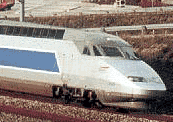|
|
|
TGVweb > TGV Trainsets > TGV Réseau |
Serve this page from: California, USA / Pisa, Italy |
The TGV Réseau trainsets are a close derivative of the TGV Atlantique trainsets. There are more differences than meet the eye, other than the 8 trailers (instead of 10 on the TGV A). As the name "Réseau" (Network) implies, these trainsets are intended to cover all the existing high-speed lines, often making trips without a stop in Paris, such as for example Marseille-Lille. The 8 trailer configuration was chosen for maximum versatility with regards to platform length, and standardized platform markings for the trailers from different trainsets. (Most stations used by TGVs have markers on the edge of the platform, so passengers can assemble directly in front of where the door of the correct trailer will be when the train stops at the station.)

Build Dates:1992-1996
Territory: Mostly LGV Nord-Europe, entire TGV network
Top Speed: 300 km/h
Number in Service: 80 (see fleet list for numbering)
Supply Voltages: 25kV 50Hz AC, 1.5kV DC (3kV DC for some)
Traction: Same as TGV Atlantique
Length and Weight: 200 m / 386 tonnes
Configuration: 1 power car + 8 trailers + 1 power car, 377 seats (see formations)
Performance Metrics: 23 kW/tonne / 1.02 tonnes/seat / 23.34 kW/seat
Pressure Sealed: Yes
Spotting Features: 8 trailers and silver/blue livery, numbering in 500 or 4500 series. Don't confuse with PSE or Atlantique.
Images: [TGVweb] [ERS Picture Gallery]
Special Notes: Some trainsets are equipped with 3kV DC for service to Belgium or Italy. See how to tell this type apart from TGV Paris Sud-Est or TGV Atlantique trainsetsDifferences in the Power Cars
Within the power cars, there are several differences from the TGV Atlantique. The main thing to keep in mind is that SNCF conceived these units to be compatible with all current (and future) trailer sets.
Specifically, the changes are the following: The main transformer is larger, because these units might someday be called on to haul bilevel TGV Duplex trainsets, which have larger head-end power requirements. The synchronous AC traction motors have been modified to allow greater thermal loads, which will be a concern on very long haul high speed runs, including obstacles such as the 6.5 km (4 mi) 3.5% grade on the Valence extension of the Sud-Est line. The total dynamic brake capacity is up to 6.4 MW (8600 hp) from 4.8 MW (6500 hp) to allow shorter stopping distances, and hence shorter headways.
The three voltage version of the Réseau trainset, for service to Brussels, Belgium, have further modifications, made necessary by axle load constraints. Additional electrical gear for running on 3000V forced some weight to be gained elsewhere for the units to remain under the 17 metric ton per axle maximal load. To save weight, the motor gearsets and support structures were made of aluminum instead of steel, and the axles were hollowed out. The last 10 trainsets in the 4500 series (4521 to 4530) will be capable of running in the Netherlands.
The TVM 430 Cab Signal
The TGV Réseau is the first to be equipped with the TVM 430 cab signal, adopted on the Nord-Europe line. It also carries the KVB beacon-based speed control, and the three voltage sets are further equipped with Belgian cab signal. You can read another article in TGVweb to find out more about the TVM Cab Signal.
The Interior
The TGV Réseau trainsets are the first to be pressure sealed. After testing in 1989 with TGV Atlantique trainset 326 in the tunnels of the Atlantique line just out of Paris, it was determined that a full-fledged pressurization (beyond simple pressure sealing) was not necessary to overcome the uncomfortable effects of tunnels, which had been a common complaint on the TGV Atlantique line.
Seating arrangements come in two flavors: one, with 3 first class trailers (for a total capacity of 377 seats) is destined for runs to and from Paris, which tend to have many business customers. The other, with only 2 first class trailers (for a total capacity of 394 seats) is intended for longer runs avoiding Paris, for which many business travelers would choose to fly. For flexibility, one of the first class cars in the first version is convertible to second class at a later date.
The "Club Seating" common on the TGV Atlantique, with its many facing seats in pseudo-compartments, has been abandoned in favor of standard coach seating throughout. Seat pitch has been increased from the TGV A, with one less row per trailer. All seats are reclining, a feature previously available only in first class. The bar area in trailer R4 was made smaller to make room for 16 additional second class seats. The small conference room at the first class end of the trainset (adjacent to the power car) has been cut down to 6 seats, to make room for a larger luggage compartment. This modification was made to provide capacity for express packages, connecting to and from the new Charles de Gaulle airport TGV station.
TGVweb > TGV Trainsets > TGV Réseau